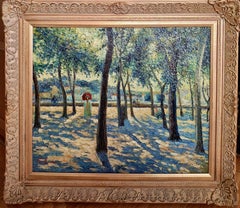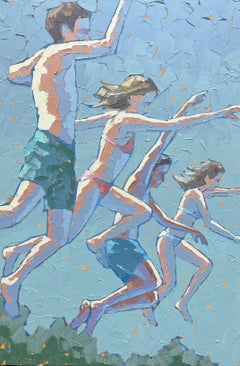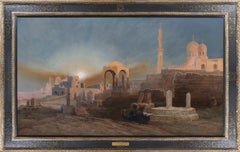Figurative Paintings
1870s English School Figurative Paintings
Oil
Late 19th Century Pre-Raphaelite Figurative Paintings
Oil
Mid-19th Century Victorian Figurative Paintings
Oil
Late 19th Century Pre-Raphaelite Figurative Paintings
Oil
1850s Victorian Figurative Paintings
Oil
Late 19th Century French School Figurative Paintings
Oil
Early 19th Century English School Figurative Paintings
Oil
Late 19th Century Pre-Raphaelite Figurative Paintings
Oil
Mid-20th Century Realist Figurative Paintings
Canvas, Oil
Early 19th Century French School Figurative Paintings
Oil, Canvas
21st Century and Contemporary Abstract Expressionist Figurative Paintings
Canvas, Ink, Acrylic
Early 1900s Tonalist Figurative Paintings
Gesso, Canvas, Oil, Stretcher Bars
1980s Figurative Paintings
Oil
Late 19th Century Symbolist Figurative Paintings
Oil, Canvas
Early 1900s Figurative Paintings
Oil
Early 19th Century Victorian Figurative Paintings
Oil, Canvas
2010s Neo-Expressionist Figurative Paintings
Acrylic, Permanent Marker
2010s Impressionist Figurative Paintings
Canvas, Acrylic
2010s Neo-Expressionist Figurative Paintings
Acrylic, Permanent Marker
Late 20th Century Modern Figurative Paintings
Oil
Artist Comments
A family eats dinner and talks about their day. The glowing, soft-focus background and amber palette evoke warmth, love, and perhaps nostalgia, while the styliz...
21st Century and Contemporary Pop Art Figurative Paintings
Oil
2010s Contemporary Figurative Paintings
Paper, Acrylic, Color Pencil
1920s Modern Figurative Paintings
Oil, Canvas
20th Century Impressionist Figurative Paintings
Canvas, Oil
21st Century and Contemporary Expressionist Figurative Paintings
Canvas, Acrylic
2010s Contemporary Figurative Paintings
Paint, Paper, Mixed Media, Acrylic, Permanent Marker
2010s Contemporary Figurative Paintings
Canvas, Acrylic
2010s Contemporary Figurative Paintings
Canvas, Acrylic
2010s Contemporary Figurative Paintings
Canvas, Acrylic
2010s Contemporary Figurative Paintings
Canvas, Acrylic
1850s Tonalist Figurative Paintings
Gesso, Canvas, Oil, Stretcher Bars
2010s Impressionist Figurative Paintings
Canvas, Acrylic
2010s Impressionist Figurative Paintings
Acrylic, Canvas
21st Century and Contemporary Pop Art Figurative Paintings
Paper, Mixed Media, Acrylic
2010s Impressionist Figurative Paintings
Oil
1920s Realist Figurative Paintings
Oil, Wood Panel
1960s Post-Impressionist Figurative Paintings
Board, Oil
2010s Contemporary Figurative Paintings
Canvas, Acrylic
19th Century French School Figurative Paintings
Oil
2010s Contemporary Figurative Paintings
Canvas, Acrylic
20th Century Impressionist Figurative Paintings
Oil
18th Century Rococo Figurative Paintings
Oak, Oil, Wood Panel
2010s Figurative Paintings
Oil, Panel
Early 1900s Tonalist Figurative Paintings
Canvas, Stretcher Bars, Oil, Gesso
1910s Impressionist Figurative Paintings
Canvas, Oil
1890s Victorian Figurative Paintings
Oil
21st Century and Contemporary Contemporary Figurative Paintings
Textile, Paint, Mixed Media
2010s Contemporary Figurative Paintings
Canvas, Acrylic, Gouache
2010s American Impressionist Figurative Paintings
Canvas, Oil
2010s Contemporary Figurative Paintings
Canvas, Oil, Acrylic
21st Century and Contemporary Contemporary Figurative Paintings
Canvas, Oil, Acrylic
20th Century English School Figurative Paintings
Oil
19th Century Old Masters Figurative Paintings
Oil
Late 19th Century Other Art Style Figurative Paintings
Paper, Oil, Cardboard
Mid-20th Century Post-Impressionist Figurative Paintings
Oil
Mid-20th Century Impressionist Figurative Paintings
Canvas, Gouache
2010s Contemporary Figurative Paintings
Canvas, Acrylic
21st Century and Contemporary Abstract Figurative Paintings
Canvas, Oil Pastel, Mixed Media, Acrylic
21st Century and Contemporary Abstract Expressionist Figurative Paintings
Canvas, Ink, Acrylic
2010s Contemporary Figurative Paintings
Paper, Mixed Media, Oil Pastel
Figurative Paintings for Sale
Figurative art, as opposed to abstract art, retains features from the observable world in its representational depictions of subject matter. Most commonly, figurative paintings reference and explore the human body, but they can also include landscapes, architecture, plants and animals — all portrayed with realism.
While the oldest figurative art dates back tens of thousands of years to cave wall paintings, figurative works made from observation became especially prominent in the early Renaissance. Artists like Michelangelo, Leonardo da Vinci and other Renaissance masters created naturalistic representations of their subjects.
Pablo Picasso is lauded for laying the foundation for modern figurative art in the 1920s. Although abstracted, this work held a strong connection to representing people and other subjects. Other famous figurative artists include Francis Bacon and Lucian Freud. Figurative art in the 20th century would span such diverse genres as Expressionism, Pop art and Surrealism.
Today, a number of figural artists — such as Sedrick Huckaby, Daisy Patton and Eileen Cooper — are making art that uses the human body as its subject.
Because figurative art represents subjects from the real world, natural colors are common in these paintings. A piece of figurative art can be an exciting starting point for setting a tone and creating a color palette in a room.
Browse an extensive collection of figurative paintings on 1stDibs.
Read More
See Kent Monkman’s Magical Realist Take on Frontier History
With a solo show at the Denver Art Museum and a commission from the Met, the Cree Canadian painter has become an international sensation.
Cecilia Vicuña Merges Politics, Science and Spirituality in Her Poetic Art
The Chilean creator, who has been living in exile in New York for decades, is having a major moment, receiving the biggest exhibitions, commissions and awards an artist could dream of.



